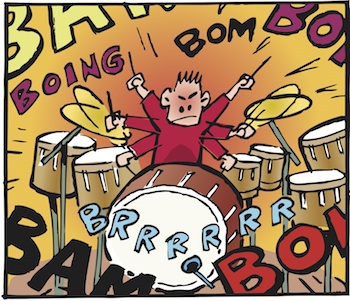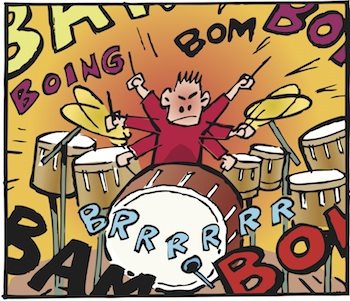Next up in our playing-by-ear series, we have another of our “home team”: Easy Ear Training author Sabrina Peña Young, sharing her perspective on playing percussion by ear.
Rhythm is more than a drum set backing a jazz band, an excited crowd clapping in time, or little black notes etched on a sheet of paper.
Rhythm is the tiniest buzzing beats of a mosquito’s wings and the enormous macrorhythms of the ocean.
As a percussionist, using my ear training skills in the live setting focuses on the overwhelming power of rhythm and timbre to create emotion, push the energy, and bring a song to a dramatic close.
Beginning drummers commonly make the mistake of jamming loudly like they are soloing to their fave band in their garage. To key into a song, to really become a musician (and not just another hack with sticks) you have to learn to appreciate the role of rhythm in a live ensemble setting.

Don’t be the overly loud drummer, oblivious to the band!
When you are the percussionist, you are the heart of the ensemble. Imagine if your heart started pounding erratically: faster than blood can pulse in your veins! Then slowed down when the going gets tough, only to go dangerously fast again a moment later.
A band playing to the beat of a bad drummer is like a marathon runner depending on a pacemaker that’s on the blitz. Don’t be that drummer!
To play rhythm by ear,
appreciate the aural signals around you
When I jam in an ensemble, whether it’s laying some rhythms down on the congas or rocking out on the drumkit, I keep my ears open for the other players. The electric bass gives me some direction for my bass drum rhythm, and the guitar and piano riffs help me figure out the right combination for the snare and high hat. A rhythmic keyboard player can help me with the overall tempo, and brass hits help me keep the accents in time.

Let your drums be in tune with their aural environment
It’s not just about playing the drums, it’s about listening and understanding orchestration, instrumentation, and timbre. My ears let me know that I shouldn’t smash out an incredible tom solo in the middle of a sensitive duet, that the pitch of a ride sounds better than the high hat in verse 1, or the buildup at the coda needs to start with the snare before it breaks out into a floor-tom jam.
Vocalists and conductors help me feel the emotion and the energy of a piece. I watch them, and I listen to them. I gauge my intensity by the intensity in their voices. As the lead vocal starts to belt out the chorus, the drums increase in intensity and emotion, and as the quiet bridge begins, I melt down to sparse percussion hits on the cymbals or a gentle rhythmic shake of a maraca. And sometimes the bad timing of a singer makes me bring out the tambourine for a reliable metronome to keep the song together.
Sure, most percussionists don’t need to worry about harmony and melody, and maybe that’s why so many of us can’t carry a tune in our pocket. But a great drummer uses his or her ears to play musically. You read that right… a musical drummer!
Next time you sit behind the set or pick up a djembe, use your ears to listen, really listen.
Then, jam on!







